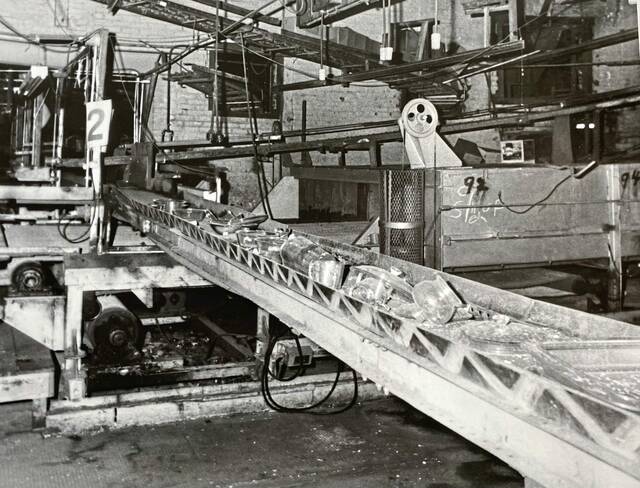Southwestern Pennsylvania's glassmaking tradition dates from late 18th century
The closure of the Pyrex cookware plant in Charleroi brings to an end 132 years of manufacturing at that facility, but the regional footprint of the glassmaking industry is far more widespread and earlier in origin.
In 1797, James O’Hara and Isaac Craig opened their Pittsburgh Glassworks at the foot of the Monongahela River, near the current site of the Duquesne Incline in the South Side. That same year, businessman Albert Gallatin’s glass factory began operating along the Mon in New Geneva, Fayette County.
By 1840, Pittsburgh had become “the pressed glass capital of the world,” according to Anne Madarasz, a glass expert and author of the book “Glass: Shattering Notions,” who discussed the topic with TribLive in 2008.
In 1827, she said, technology arrived that used iron molds and a press to create glass.
By the early 1900s, there were more than 100 glass factories in Western Pennsylvania. The region was ideal for glass manufacturing because of its thriving iron industry and plentiful supply of coal for fuel.
Jeannette
In Westmoreland County, Jeannette became known as “Glass City,” at one time home to seven glass companies.
Jeannette Bottle Works opened in 1887, becoming the Jeannette Glass Co. a year later. It turned out sheet glass and, in the 1950s, brought in Cameo Glassware to produce milk glass. In its heyday, it employed as many as 1,000. Renamed Jeannette Corp. in 1970, it shut down production in 1983.
In recent years, the plant site was purchased by Jeannette’s Elliott Group, which developed a cryogenic pump test stand there.
Jeannette’s factories at one time supplied the nation with up to 85% of its glass products before sales began shifting to cheaper overseas competitors.
In the nearby Hempfield community of Grapeville, Westmoreland Glass grew out of Specialty Glass Co. of East Liverpool, Ohio. It opened in Pennsylvania in 1889, making goblets, pitchers and novelty items now sought after by collectors..
Employing more than 350 at its height, for many years the company was led by members of the West or Brainard families. Following its 1984 demise, the shuttered plant was ravaged by two major fires — in 1996 and 1998.
Mt. Pleasant
The Mt. Pleasant area was another center of glass manufacturing — including Ford headlight lenses and decorative glassware turned out by L.E. Smith Glass Co.
Founded in 1907 by Lewis E. Smith, it got its start in a Jeannette glass plant and moved to Mt. Pleasant after Smith acquired the closed Anchor Glass Co. plant there two years later. In 1975, it was taken over by Toledo, Ohio-based glass container maker Owens-Illinois Inc.
The plant was purchased out of U.S. Bankruptcy Court in 1995 by a Belle Vernon money manager. For a time, its glassware was promoted by high-profile individuals and companies such as Martha Stewart and Neiman-Marcus.
Glass production ceased there in 2008, though some of the remaining inventory continued to be sold.
The nearby Lenox plant opened in 1970, producing crystal stemware glass and gift items. Competition from foreign imports, coupled with a lack of demand for fine crystal, closed the facility in January 2002, idling 158 workers.
The outlet store adjacent to the factory remained open for nearly two more decades. The building now is occupied by multiple tenants — including Glassautomatic/Rolf Glass, a glass engraver.
The Bryce Brothers Company produced hand-blown glass in Mt. Pleasant from 1896 to 1965. One of the places its products ended up was at the restaurant at the top of the Space Needle at Seattle’s 1962 World’s Fair.
The company’s buildings on Mt. Pleasant’s Bridgeport Street later belonged to Levin Furniture. Much of that property was destroyed in a 1998 arson.
Charleroi
Charleroi’s Corelle Brands plant is closing as the company’s Pryex production is shifting to Lancaster, Ohio.
The local plant was opened in 1893 by MacBeth Evans. It was purchased in 1937 by Corning Glass and in 1998 by World Kitchen — which made glass kitchenware for domestic and export markets.
Jeff Himler is a TribLive reporter covering Greater Latrobe, Ligonier Valley, Mt. Pleasant Area and Derry Area school districts and their communities. He also reports on transportation issues. A journalist for more than three decades, he enjoys delving into local history. He can be reached at jhimler@triblive.com.
Remove the ads from your TribLIVE reading experience but still support the journalists who create the content with TribLIVE Ad-Free.





